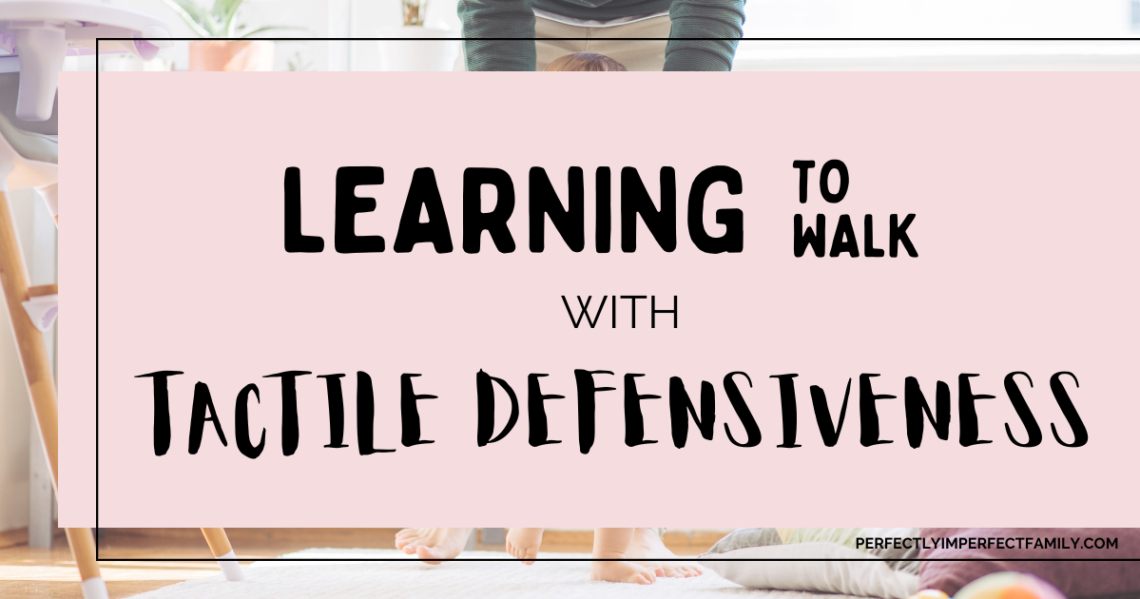Tactile Defensiveness
One of our children, our son, deals with tactile defensiveness daily. These posts talk about our experience with him as he faces his challenges and what we’ve learned and would like to share to help others continue moving forward. Maybe our experiences can be of benefit to you.
Warning Signs of Tactile Defensiveness
My son has been diagnosed with tactile defensiveness. Many of you may be wondering what tactile defensiveness is and what that means for someone with it.
Tactile defensiveness is a term used to describe hypersensitivity to touch. Individuals who experience tactile defensiveness are more bothered by the feel of things that touch their skin. Sensitivity may occur with food textures, clothing or fabric textures, self-care tasks, and receiving a hug or kiss. Or, it could be with specific items like paper, pencil, or messy play. Individuals who are sensitive to touch may respond by avoiding sensations or having a more significant reaction than would be expected or seen in others.
Looking back on my son’s childhood up until his diagnosis, there were a lot of warning signs of tactile defensiveness.
My son was my first child. When we brought him home from the hospital, we quickly noticed that he would cry every single time that we changed his diaper. With him being my first, I didn’t think anything of it. I figured that is how babies were. My mom lived close by and came over quite a bit the first week we were home from the hospital. She kept saying that he shouldn’t be crying when his diaper was changed. So we started trying many things to make him comfortable when we changed him. We tried different diapers, but that didn’t work. We tried different wipes, and that helped a little bit. We settled on a very soft wipe. He didn’t stop crying when we changed him until my mom bought us a wipe warmer. Luckily, after a couple of months, this finally got him to stop crying. It wasn’t until our diagnosis that we didn’t fully understand why he was crying when we changed him. He didn’t like the feel of the cold wipe on his bum.
Another strange thing that happened was at bath time. He loved being in the bath, but he would start crying as soon as we would get him out. It was every single time. We thought it might be because he didn’t want to get out of the bath. That wasn’t it, though. It was a different kind of cry. He would also cry hard when I rubbed lotion on him after his bath. My mom once again mentioned that he shouldn’t cry when I put lotion on him. We couldn’t figure out why he was doing that. Let’s say that I dreaded bath time. I would go as long as I could without bathing him because it was an awful experience. Once again, we didn’t understand why he was crying at bath time until we got our diagnosis of tactile defensiveness. He didn’t like the feel of the cold when he got out of the bath. He hated the feeling of me rubbing lotion all over his body.
Those were the two significant early signs of tactile defensiveness.
Another sign that I remember is that he hated baby food. It didn’t matter what it was he didn’t like it. I could get him to eat some of the fruit because it was sweet, but he didn’t enjoy baby food. Once he started eating solid foods, he only ate solid things, like chicken nuggets. He wouldn’t eat anything slimy or gooey. We still have a problem with this, which is our most challenging battle.
Looking back, another sign I can remember is that he wouldn’t touch certain things with his fingers or hands. He would never pick things up and put them in his mouth. Do you know how some babies find things on the ground and put them in their mouths? He never did this. I am unsure if it was because he was just a good baby or because he never wanted anything in his mouth. He never had his toys in his mouth or balls or anything like that.
These are the things that I can remember that were definite signs of tactile defensiveness after looking back on them. Once we got our diagnosis of tactile defensiveness, everything up to that point made so much sense.
Helping a Child with Tactile Defensiveness Overcome Eating Challenges
Tactile defensiveness can pose significant challenges for children when it comes to eating. Sensory sensitivities can make mealtimes overwhelming and stressful. However, with patience, understanding, and a strategic approach, parents and caregivers can help their children overcome tactile defensiveness and develop a healthier relationship with food.
Understanding Tactile Defensiveness
Tactile defensiveness, or tactile hypersensitivity, is a condition where individuals experience an overreaction to certain tactile stimuli. For children with tactile defensiveness, the textures, temperatures, and physical sensations associated with food can trigger aversive responses, making eating a daunting task. It is important to remember that each child’s experience is unique, and their aversions may vary.
Create a Calm and Supportive Environment
Creating a calm and supportive environment during mealtimes is crucial for helping a child with tactile defensiveness. Reduce distractions, such as loud noises or bright lights, that may heighten their sensory overload. Establish a predictable routine and provide clear expectations. Encourage positive associations with food by incorporating enjoyable activities or storytelling into mealtimes.
Gradual Exposure to New Foods
Introducing new foods gradually is key to helping a child with tactile defensiveness expand their palate. Start with small portions of unfamiliar foods and pair them with preferred items. Please encourage them to gradually explore the new food with their senses, allowing them to touch, smell, and interact with it without pressure to eat. Celebrate any progress made, regardless of how small it may seem.
Food Texture Modifications
Food textures can be particularly challenging for children with tactile defensiveness. Modifying the textures of certain foods can help make them more manageable. Pureeing or blending foods to create smoother textures or offering crunchy alternatives like vegetable sticks instead of raw fruits can provide more tolerable options for children with tactile sensitivities.
Consulting with Occupational Therapists
Occupational therapists specializing in sensory processing can provide valuable guidance and strategies tailored to your child’s needs. They can offer techniques to desensitize their tactile sensitivity over time and suggest activities to improve sensory integration. Collaborating with these professionals can significantly enhance your child’s progress and overall well-being.
Helping a child with tactile defensiveness overcome eating challenges requires patience, understanding, and a supportive approach. By creating a calm environment, gradually introducing new foods, and seeking professional assistance, parents can empower their children to develop healthier relationships with food.
A Mother’s Experience With Tactile Defensiveness
I am sure there are some of you reading this who are wondering what tactile defensiveness is. It is a term used to describe someone very sensitive to touch. As a result, someone who experiences tactile defensiveness is much more sensitive to touch than usual.
Our son has been diagnosed with tactile defensiveness. He received his diagnosis when he was 18 months old. As parents, we became concerned that he wasn’t walking or trying to walk. It also concerned us that he would pull his feet up to avoid standing when we would try and have him stand up on our laps. Also, when we would try and have him stand up on the ground, he would do the same thing. He would never let the bottom of his feet touch anything and do everything he could to avoid it!
My husband and I asked our family doctor about our concerns, and he referred us to a physical therapist. When we went to the physical therapist, our son was diagnosed five minutes into our appointment. It was extremely quick. It surprised me, but the therapist immediately knew our son’s diagnosis as he watched our son’s behavior! Our son avoided physical contact because of how things felt on his skin. The therapist explained it like this to me. He said that when you cut your fingernails too short, the skin under the nail gets exposed, and it feels weird. He said that is the feeling my son has all over his body.
After I learned what it was, we realized that there were signs of it from the day he was born. He would always cry whenever we would change his diaper. He would also cry and scream whenever we bathed him, and I would rub lotion on him. He hated that.
He also didn’t like to touch things with his hands. He didn’t want to touch anything slimy or gooey. We would have him play with shaving cream or pudding with his fingers. He hated this and didn’t do very well with this one.
He was never a great eater either. When he got a little older, maybe age two or two and a half, we realized that he had tactile defensiveness in his mouth. He hated baby food. He hated fruit or veggies. He liked more solid things, like chicken nuggets or quesadillas. His eating to this day, ten years later, is still our biggest challenge. His list of foods that he will eat is minimal. And when he does eat, he picks at things and puts a small amount of food in his mouth. Eating for him is a chore. I am always trying to find something that he will eat, and I get frustrated when he doesn’t like most things I make.
Tactile defensiveness is something our son will have to deal with his entire life. He has just learned to live with most of the things he doesn’t like to touch. Some things will always be a challenge for him, mainly his eating. Now that he is getting older, there are just simple things that you wouldn’t think about, like face wash. Just washing his face is a struggle. We quickly learned that he could not use the foaming face wash! There are just so many tiny things that pop up as he gets older that we work through. He is a great kid and works through everything so well.
So, where are all my people out there who have someone with tactile defensiveness in their lives? I would love to hear from you.
Learning to Walk With Tactile Defensiveness
After our son was diagnosed with tactile defensiveness, we had much to learn. As parents, we needed to understand what tactile defensiveness was. Neither my husband nor I had ever heard of it before. We also needed to know what we could do at home to help him. We also had to educate our families on it. No one in our families had heard of it either.
Our number one concern after his diagnosis was helping him learn to walk. It took us almost five months to achieve this goal, from the diagnosis to his being able to walk on his own. We took these steps as parents to help him learn to walk.
1. Physical Therapy
We would go to physical therapy regularly. We would never have known what to do if we hadn’t kept going. There were so many different activities at physical therapy that they would do with our son. I can’t remember everything that they did, but the one thing that they used was hanging beads. All they would do is have our son put his feet under these hanging beads, and they would make them swing across his feet. At first, he hated this, but eventually, he got used to it. They always gave us this to do at home when we went to therapy.
2. Brushing His Feet
One of the primary activities the therapist would have us do at home was brushing our son’s feet. It sounds a little weird, and you probably wonder what that is. Our therapist gave us this little sponge that was soft on one side, and on the other side, it had tiny bristles. All we would do would take his feet, and with the bristle side of the sponge, we would brush his feet. We would constantly brush up and down across the bottom of his feet. He did not like this feeling at all. It took a couple of weeks to get used to the sensation on the bottom of his feet.
3. Going Barefoot
We only took him outside in his bare feet for this one. We would have him touch his feet on different textures. We put his feet on the cement or in the sand. We would try anything we could think of that would feel foreign to him. The one he hated the most was the grass. It took him a long time to be comfortable touching the grass with his feet.
4. Using a Walker
The last thing that the therapist had us do was use a walker. He needed the walker to get strength in his legs. You have to realize that he had never stood up on his legs at this point. When moms take their babies, hold them up on their laps, and stand up, you look at the baby while helping them stand. My son never did that. You never realize how that tiny little thing was such a big deal. Since he had never stood on his legs, they were weak. We used the tiniest little gold walker you would have ever seen. It only took him about a week to learn how to use the walker, and then he was off. We couldn’t slow him down after that. He used the walker for a couple of months.
After months of doing these things, our son finally started walking independently. It was the best day of his life when he could finally walk without any help. Walking hasn’t been his only setback. He also had to learn how to touch things with his hands. To this day, eating has been and continues to be the biggest obstacle. Please read my other posts about the strange things we would do for him to get used to touching things and eating.


